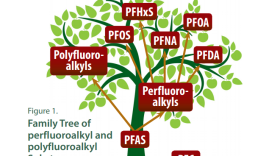Two members of Congress from Michigan re-introduced bipartisan legislation Tuesday to set national drinking water standards for two PFAS chemicals. WAMC’s Hudson Valley Bureau Chief Allison Dunne says New Yorkers are watching closely.
Democratic Congresswoman Debbie Dingell and Republican Congressman Fred Upton authored the PFAS Action Act of 2021 to create national drinking water standards for PFOA and PFOS. Upton says the legislation would require the U.S. Environmental Protection Agency to establish standards for the two “forever chemicals” within two years.
“And what this legislation intends to do is to get EPA on our side. We need a partner,” Upton says. “We need a partner that can battle this, to identify those hot spots, to work with companies across the nation, to inform consumers and to take the meaningful steps of actually cleaning up where there’s contaminated sites.”
EPA has an advisory level of 70 parts per trillion each for PFOA and PFOS. Dingell says in July 2018, the city of Parchment, Michigan’s public water supply system became the first system in the state with PFAS results several times higher than the EPA advisory level.
“We need strong federal leadership now to address these pervasive and harmful chemicals,” Dingell says. “The American people need the PFAS Action Act enacted into law without delay.”
In 2020, Michigan adopted maximum contaminant levels for seven PFAS chemicals, including 8 parts per trillion for PFOA and 16 parts per trillion for PFOS. Earlier this year, EPA announced how it is moving forward with its PFAS Action Plan, including with its intent to regulate PFOA and PFOS in drinking water after further analyses, scientific review and public comment. Actor and activist Mark Ruffalo:
“The bill doesn’t give the EPA any new powers,” Ruffalo says. “It just tells the EPA to use the powers that Congress gave the EPA more than 40 years ago.”
Ruffalo mentions his 2019 film based on a true story.
“I played the role of Rob Bilott in the movie ‘Dark Waters,’ which I produced and developed. And this is a story about a company knowingly discharging toxic PFAS into the air and water in Parkersburg, West Virginia,” says Ruffalo. “After making ‘Dark Waters,’ here’s what still amazes me.”
After going through a list, he ends up here:
“What’s amazing to me is that, in roughly, there’s roughly 2, 500 companies today that are still likely discharging PFAS into the air and water as you and I are partaking in this event,” says Ruffalo.
The event being the virtual press conference with Dingell and Upton, and Scott Faber, who is senior vice president for government affairs for the Environmental Working Group.
“After decades of inaction, it’s really time for action. It’s time to quickly designate PFOA and PFOS, at a minimum, as hazardous substances, to kick start the cleanup process. It’s time to quickly set a drinking water standard. It’s time to set limits on releases of PFAS into the air and water,” Faber says. “And while setting deadline will not be enough, we also need to provide resources to upgrade our water infrastructure and clean up PFAS at DOD installations, it’s really critical to set deadlines for action.”
The PFAS Action Act would designate PFOA and PFOS chemicals as hazardous substances within one year and require the EPA to determine whether to list other PFAS within five years.
“The president’s pledge to set a drinking water standard for PFAS and to designate some PFAS as hazardous substances is really welcome news, but communities impacted by PFAS have heard pledges and promises before,” says Faber. “And under current rules, it could be almost four years before EPA even sets a drinking water standard, and years longer before utilities would have to meet it. It could be even longer than that before EPA issues standards for the industrial releases Mark was talking about of PFAS into the air and water.”
Hundreds of military sites across the U.S. are contaminated with PFAS, inclduing Newburgh’s Stewart Air National Guard base. New York adopted maximum contaminant levels for PFOA and PFOS in July 2020 – 10 parts per trillion each. The state also adopted a 1 part-per-billion MCL for 1,4-Dioxane. Again, Upton:
“We need to make sure that there’s, there’s a commitment from the Department of Defense that they’re going to be good neighbors, that they’re going to clean up these communities and going to be full partners to make sure that that’s done,” Upton says. “And I’m, I’m, this, this legislation will help us see that day.”
Dingell is hopeful the legislation will have the support of the Senate this year.
“I’m hopeful things will be different with the Democratic-controlled Senate and the Biden/Harris administration who has committed to addressing the PFAS crisis,” says Dingell.
Again, Ruffalo.
“In this divided climate we’re in, water’s a really good way for us to find common ground,” Ruffalo says.
In January 2020, the House passed the PFAS Action Act by a vote of 247 to 159, including 24 Republicans supporting the package. The text introduced Tuesday is largely identical to the version passed in the 116th Congress.









